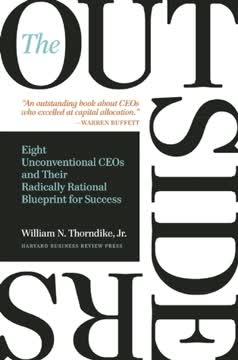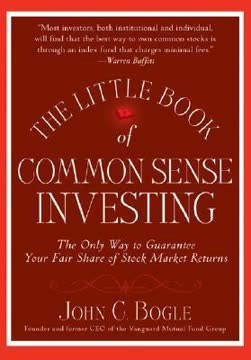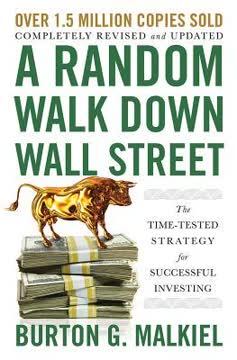نکات کلیدی
1. مغز ما برای سرمایهگذاری احساسی سیمکشی شده است
"احساسات برای غلبه بر منطق طراحی شدهاند."
دو سیستم تفکر. مغز ما دو سیستم برای تصمیمگیری دارد: سیستم احساسی X و سیستم منطقی C. سیستم X سریع، خودکار و اغلب بر اساس شهود است، در حالی که سیستم C کندتر، متفکرانهتر و منطقی است. در سرمایهگذاری، سیستم X میتواند به تصمیمات عجولانه بر اساس ترس یا طمع منجر شود.
غلبه بر تعصب احساسی. برای اتخاذ تصمیمات بهتر در سرمایهگذاری، باید بیشتر از سیستم C استفاده کنیم. این کار میتواند با:
- کند کردن فرآیندهای تصمیمگیری
- جستجوی اطلاعات متناقض
- استفاده از استراتژیهای پیشتعهد، مانند تعیین قوانین برای خرید یا فروش
- توسعه یک رویکرد سیستماتیک سرمایهگذاری
درک این دامهای ذهنی برای سرمایهگذاران حیاتی است. با شناخت زمانی که احساسات تصمیمات را هدایت میکنند، میتوانیم اقداماتی برای مقابله با آنها انجام دهیم و انتخابهای منطقیتری داشته باشیم.
2. اعتماد به نفس بیش از حد: دشمن سرمایهگذاری هوشمند
"کسانی که دانش دارند پیشبینی نمیکنند. کسانی که پیشبینی میکنند دانش ندارند."
توهم کنترل. سرمایهگذاران اغلب توانایی خود را در پیشبینی حرکات بازار و انتخاب سهام برنده بیش از حد ارزیابی میکنند. این اعتماد به نفس بیش از حد منجر به معاملات بیش از حد میشود که معمولاً به دلیل هزینههای تراکنش و زمانبندی ضعیف به بازدهی کمتری منجر میشود.
متخصصان نیز مصون نیستند. مطالعات نشان میدهد که تحلیلگران حرفهای و مدیران صندوقها نیز به اندازه سرمایهگذاران فردی به اعتماد به نفس بیش از حد دچار میشوند. پیشبینیهای آنها اغلب دقیقتر از شانس نیست، اما با اطمینان بالایی بیان میشوند.
برای مقابله با اعتماد به نفس بیش از حد:
- یک دفترچه سرمایهگذاری دقیق برای پیگیری تصمیمات و نتایج نگه دارید
- به طور منظم اشتباهات گذشته را مرور و تحلیل کنید
- به دنبال نظرات و دیدگاههای متنوع باشید
- بر فرآیند تمرکز کنید نه نتایج کوتاهمدت
3. حماقت پیشبینی در امور مالی
"ما به سادگی نمیدانیم."
بیفایده بودن پیشبینی. تحقیقات گسترده نشان میدهد که پیشبینیهای مالی، چه برای شاخصهای اقتصادی، درآمدها یا قیمت سهام، به طور مداوم نادرست هستند. با این حال، صنعت سرمایهگذاری همچنان به تلاش برای پیشبینی آینده وسواس دارد.
رویکردهای جایگزین. به جای تکیه بر پیشبینیها، سرمایهگذاران باید:
- بر درک ارزش ذاتی یک شرکت تمرکز کنند
- به دنبال حاشیه ایمنی در ارزیابیها باشند
- برای سناریوهای متعدد آماده شوند به جای تلاش برای پیشبینی یک نتیجه واحد
- از مدلهای DCF معکوس برای درک انتظارات بازار استفاده کنند
با پذیرش عدم قطعیت ذاتی در بازارها، سرمایهگذاران میتوانند بر فعالیتهای سازندهتری تمرکز کنند که به فرآیند سرمایهگذاری آنها ارزش میافزاید.
4. اضافهبار اطلاعات: کمتر اغلب بیشتر است
"تحلیل باید نافذ باشد نه پیشگویانه."
خطرات اطلاعات بیش از حد. مطالعات نشان میدهد که دسترسی به اطلاعات بیشتر اغلب به دقت کمتر اما اعتماد به نفس بیشتر در تصمیمات سرمایهگذاری منجر میشود. این پارادوکس به این دلیل رخ میدهد که انسانها ظرفیت پردازش محدودی دارند و در هنگام غرق شدن در اطلاعات، تمایل به تمرکز بر دادههای کمتر مرتبط دارند.
تمرکز بر آنچه مهم است. برای مقابله با اضافهبار اطلاعات:
- 3-5 عامل کلیدی که موفقیت یک سرمایهگذاری را هدایت میکنند شناسایی کنید
- چکلیستهای ساده برای راهنمایی تصمیمگیری ایجاد کنید
- مواجهه با نویز کوتاهمدت بازار و رسانههای مالی را محدود کنید
- به طور منظم منابع اطلاعاتی خود را مرور و اصلاح کنید
با تمرکز بر چند قطعه اطلاعات حیاتی، سرمایهگذاران میتوانند تصمیمات بهتری بگیرند و از دامهای تحلیل فلجکننده اجتناب کنند.
5. آواز فریبنده داستانها در تصمیمات سرمایهگذاری
"ما شواهد را به نفع یک داستان خوب رها خواهیم کرد."
قدرت روایتها. انسانها به طور طبیعی به داستانهای جذاب جذب میشوند، اغلب به قیمت تحلیل واقعی. در سرمایهگذاری، این میتواند به ارزشگذاری بیش از حد سهام با روایتهای هیجانانگیز (مانند IPOها) و ارزشگذاری کمتر کسبوکارهای محکم اما کسلکننده منجر شود.
تمرکز بر حقایق. برای اجتناب از تأثیرپذیری از روایتها:
- داستانهای کیفی را از دادههای کمی جدا کنید
- به دنبال شواهدی باشید که روایت غالب را نقض میکند
- از چکلیستها و فرآیندهای سیستماتیک برای ارزیابی سرمایهگذاریها استفاده کنید
- به ویژه نسبت به داستانهای "عصر جدید" و "این بار متفاوت است" شکاک باشید
با حفظ شک و تردید سالم نسبت به روایتها و تمرکز بر دادههای سخت، سرمایهگذاران میتوانند از دامهای رایج اجتناب کنند و فرصتهای واقعاً ارزشمند را شناسایی کنند.
6. سرمایهگذاری مخالف: قدرت رفتن بر خلاف جمعیت
"تولید عملکرد برتر غیرممکن است مگر اینکه کاری متفاوت از اکثریت انجام دهید."
درد عدم تطابق. رفتن بر خلاف جمعیت از نظر روانی دشوار است. مطالعات نشان میدهد که طرد اجتماعی همان نواحی مغز را فعال میکند که درد جسمی، که توضیح میدهد چرا بسیاری از سرمایهگذاران برای مخالف بودن تلاش میکنند.
پرورش تفکر مخالف. برای تبدیل شدن به یک سرمایهگذار مخالف موفق:
- درک قوی از تاریخ و چرخههای بازار ایجاد کنید
- از طریق تحقیق و تحلیل دقیق اطمینان حاصل کنید
- شبکهای از سرمایهگذاران همفکر ایجاد کنید
- برای دورههای عملکرد ضعیف و ناراحتی اجتماعی آماده باشید
به یاد داشته باشید که بزرگترین فرصتهای سرمایهگذاری اغلب زمانی به وجود میآیند که ترس یا سرخوشی در اوج خود هستند و اکثر سرمایهگذاران به طور غیرمنطقی عمل میکنند.
7. اجتناب از ضرر: چرا نمیتوانیم از سرمایهگذاریهای زیانده دست بکشیم
"باید بدانید چه زمانی نگه دارید، چه زمانی رها کنید، چه زمانی دور شوید و چه زمانی فرار کنید."
روانشناسی ضررها. انسانها درد ضررها را تقریباً دو برابر لذت سودهای معادل احساس میکنند. این منجر به رفتارهایی مانند نگه داشتن سهام زیانده برای مدت طولانی و فروش زودهنگام برندگان میشود.
غلبه بر اجتناب از ضرر. استراتژیهایی برای مقابله با این تعصب شامل:
- تعیین قوانین فروش از پیش تعیینشده یا توقف ضرر
- به طور منظم موقعیتها را مرور کنید گویی که آنها را تازه خریداری کردهاید
- تمرکز بر عملکرد کلی پرتفوی به جای موقعیتهای فردی
- درک تفاوت بین ضررهای موقت کاغذی و ضررهای دائمی سرمایه
با شناخت و مدیریت فعالانه اجتناب از ضرر، میتوانیم تصمیمات منطقیتری درباره زمان قطع ضررها و زمان اجازه دادن به برندگان بگیریم.
8. تمرکز بر فرآیند، نه نتایج، برای موفقیت بلندمدت
"سازمانهای قهرمانی، با این حال، به طور انحصاری در نیمه بالای ماتریس قرار دارند."
اهمیت فرآیند. در کوتاهمدت، تصمیمات خوب میتوانند به دلیل تصادفی بودن به نتایج بد منجر شوند. برعکس، تصمیمات ضعیف گاهی اوقات میتوانند به نتایج خوب منجر شوند. تمرکز صرف بر نتایج میتواند عادات بد را تقویت کند و به عملکرد ضعیف بلندمدت منجر شود.
ساختن یک فرآیند سرمایهگذاری قوی. عناصر کلیدی شامل:
- توسعه یک فلسفه و استراتژی سرمایهگذاری واضح
- ایجاد قوانین سیستماتیک برای خرید، فروش و اندازهگیری موقعیت
- به طور منظم فرآیند خود را بر اساس اطلاعات جدید مرور و اصلاح کنید
- عملکرد را در برابر معیارهای مناسب در افقهای زمانی طولانی اندازهگیری کنید
با تمرکز بر ساختن و پیروی از یک فرآیند سرمایهگذاری صحیح، سرمایهگذاران میتوانند شانس موفقیت خود را افزایش دهند و در دورههای نوسانات بازار یا عملکرد ضعیف کوتاهمدت انضباط خود را حفظ کنند.
آخرین بهروزرسانی::
FAQ
What's "The Little Book of Behavioral Investing" about?
- Behavioral Finance Focus: The book explores how human psychology affects investment decisions, often leading to suboptimal outcomes.
- Common Pitfalls: It identifies common behavioral biases that investors face, such as overconfidence, loss aversion, and the tendency to follow the crowd.
- Improving Decision-Making: The author, James Montier, provides strategies to recognize and mitigate these biases to improve investment performance.
- Practical Examples: The book uses real-world examples and anecdotes to illustrate how these biases manifest in everyday investing.
Why should I read "The Little Book of Behavioral Investing"?
- Understand Your Biases: It helps readers identify their own psychological biases that can negatively impact investment decisions.
- Improve Investment Returns: By learning to control these biases, investors can potentially improve their investment returns.
- Expert Insights: The book offers insights from some of the world's best investors on how they manage behavioral challenges.
- Engaging and Accessible: Written in an engaging style, it makes complex psychological concepts accessible to a broad audience.
What are the key takeaways of "The Little Book of Behavioral Investing"?
- Self-Awareness is Crucial: Recognizing one's own biases is the first step toward better investment decisions.
- Pre-Commitment Strategies: Planning and committing to a strategy in advance can help avoid emotional decision-making.
- Skepticism and Critical Thinking: Investors should cultivate skepticism and focus on facts rather than stories or market noise.
- Long-Term Focus: Patience and a long-term perspective are essential to overcoming short-term market volatility and biases.
What are the best quotes from "The Little Book of Behavioral Investing" and what do they mean?
- "The investor’s chief problem—and even his worst enemy—is likely to be himself." This highlights the idea that personal biases and emotions are significant obstacles to successful investing.
- "Investing is simple but not easy." This suggests that while the principles of investing are straightforward, executing them without succumbing to biases is challenging.
- "The time of maximum pessimism is the best time to buy." This quote emphasizes the contrarian approach of buying when others are fearful, which can lead to better investment opportunities.
- "You can’t predict, you can prepare." This underscores the importance of preparation and process over trying to forecast market movements.
How does James Montier suggest overcoming behavioral biases in investing?
- Pre-Commitment: Montier advises investors to prepare and pre-commit to strategies when in a rational state, avoiding decisions made in the heat of the moment.
- Focus on Process: Emphasizing a disciplined investment process can help mitigate the influence of emotions and biases.
- Critical Thinking: Investors should question assumptions and seek disconfirming evidence to avoid confirmatory bias.
- Learn from Mistakes: Keeping an investment diary can help track decisions and learn from past mistakes, distinguishing between luck and skill.
What is the "X-system" and "C-system" in "The Little Book of Behavioral Investing"?
- X-System: This represents the emotional, quick, and automatic way of processing information, often leading to biases and errors.
- C-System: In contrast, the C-system is the logical, deliberate, and effortful way of thinking, which is slower but more accurate.
- Balancing Both Systems: Montier suggests that while both systems are necessary, investors should strive to engage the C-system more in decision-making.
- Practical Application: Understanding these systems can help investors recognize when they are making decisions based on emotion rather than logic.
What role does overconfidence play in investing according to James Montier?
- Common Bias: Overconfidence is a prevalent bias where investors overestimate their knowledge and ability to predict market movements.
- Impact on Trading: It often leads to excessive trading, which can erode returns due to transaction costs and poor timing.
- Expert Overconfidence: Even experts are not immune, often displaying more overconfidence than laypeople, which can lead to significant errors.
- Mitigation Strategies: Montier suggests being aware of this bias and implementing checks, such as seeking diverse opinions and focusing on process over predictions.
How does "The Little Book of Behavioral Investing" address the issue of information overload?
- More Isn't Always Better: Montier argues that more information can lead to overconfidence without improving decision accuracy.
- Focus on Key Factors: Investors should identify and focus on the few critical factors that truly impact investment decisions.
- Checklists and Simplicity: Using checklists can help streamline decision-making and ensure focus on relevant information.
- Avoiding Noise: Montier advises turning off "bubblevision" and ignoring market noise to concentrate on long-term fundamentals.
What is the "disposition effect" and how does it affect investors?
- Definition: The disposition effect is the tendency to sell winning investments too early and hold onto losing ones too long.
- Emotional Attachment: This behavior is driven by loss aversion and the reluctance to realize losses, hoping for a rebound.
- Impact on Returns: It can lead to suboptimal portfolio performance as investors miss out on potential gains and incur larger losses.
- Overcoming the Effect: Montier suggests using stop-loss orders and focusing on the overall portfolio strategy rather than individual stock performance.
How does James Montier suggest dealing with market bubbles?
- Recognizing Patterns: Montier provides a framework for identifying bubbles, emphasizing historical patterns and psychological factors.
- Avoiding Herd Mentality: Investors should resist the urge to follow the crowd and instead focus on fundamentals and valuations.
- Long-Term Perspective: Maintaining a long-term view can help investors avoid getting caught up in speculative frenzies.
- Preparedness Over Prediction: Montier stresses the importance of being prepared for bubbles rather than trying to predict their timing.
What is the significance of "process accountability" in investing?
- Focus on Process: Montier emphasizes the importance of focusing on the investment process rather than short-term outcomes.
- Reducing Biases: A strong process can help mitigate biases and lead to more consistent long-term performance.
- Learning from Outcomes: By analyzing decisions based on process rather than results, investors can better understand their strengths and weaknesses.
- Sustainable Success: A disciplined process is key to achieving sustainable investment success, even in the face of market volatility.
How can investors apply the lessons from "The Little Book of Behavioral Investing" to their portfolios?
- Identify Biases: Start by recognizing personal biases and how they affect investment decisions.
- Develop a Process: Create a disciplined investment process that includes pre-commitment strategies and regular reviews.
- Focus on Fundamentals: Prioritize fundamental analysis over market noise and short-term fluctuations.
- Continuous Learning: Keep an investment diary to track decisions and learn from both successes and mistakes, refining the process over time.
نقد و بررسی
کتاب کتاب کوچک سرمایهگذاری رفتاری به دلیل توضیح مختصر و مفید خود دربارهی تعصبات شناختی که بر سرمایهگذاران تأثیر میگذارد، عمدتاً نقدهای مثبتی دریافت میکند. خوانندگان از نکات عملی، مثالهای واقعی و تأکید آن بر فرآیند به جای نتایج قدردانی میکنند. بسیاری آن را مقدمهای ارزشمند برای مالی رفتاری میدانند، اگرچه برخی اشاره میکنند که محتوای آن ممکن است برای کسانی که قبلاً با این موضوع آشنا هستند، آشنا باشد. تمرکز کتاب بر غلبه بر تمایلات انسانی در سرمایهگذاری مورد تحسین قرار میگیرد، اما چند منتقد معتقدند که فاقد توصیههای عملی و قابل اجرا برای پیادهسازی مفاهیم آن است.
Similar Books















